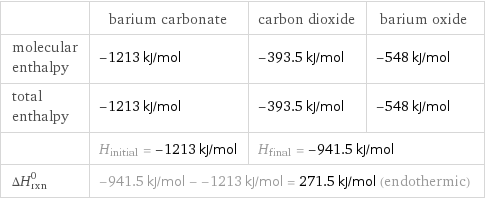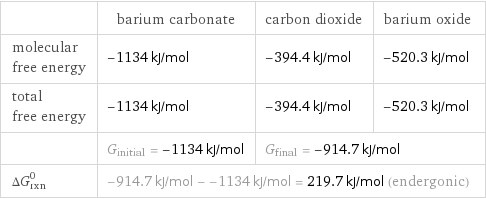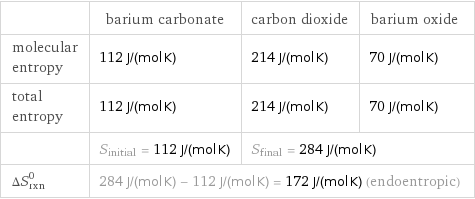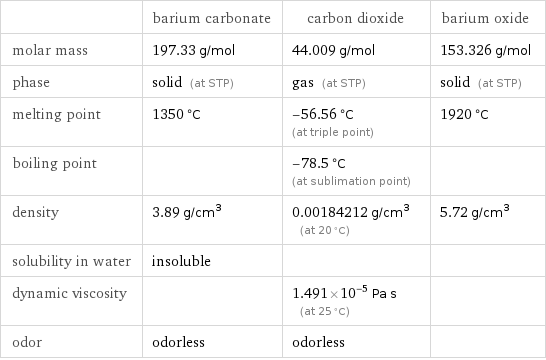Input interpretation

BaCO_3 (barium carbonate) ⟶ CO_2 (carbon dioxide) + BaO (barium oxide)
Balanced equation

Balance the chemical equation algebraically: BaCO_3 ⟶ CO_2 + BaO Add stoichiometric coefficients, c_i, to the reactants and products: c_1 BaCO_3 ⟶ c_2 CO_2 + c_3 BaO Set the number of atoms in the reactants equal to the number of atoms in the products for Ba, C and O: Ba: | c_1 = c_3 C: | c_1 = c_2 O: | 3 c_1 = 2 c_2 + c_3 Since the coefficients are relative quantities and underdetermined, choose a coefficient to set arbitrarily. To keep the coefficients small, the arbitrary value is ordinarily one. For instance, set c_1 = 1 and solve the system of equations for the remaining coefficients: c_1 = 1 c_2 = 1 c_3 = 1 Substitute the coefficients into the chemical reaction to obtain the balanced equation: Answer: | | BaCO_3 ⟶ CO_2 + BaO
Structures

⟶ +
Names

barium carbonate ⟶ carbon dioxide + barium oxide
Reaction thermodynamics
Enthalpy

| barium carbonate | carbon dioxide | barium oxide molecular enthalpy | -1213 kJ/mol | -393.5 kJ/mol | -548 kJ/mol total enthalpy | -1213 kJ/mol | -393.5 kJ/mol | -548 kJ/mol | H_initial = -1213 kJ/mol | H_final = -941.5 kJ/mol | ΔH_rxn^0 | -941.5 kJ/mol - -1213 kJ/mol = 271.5 kJ/mol (endothermic) | |
Gibbs free energy

| barium carbonate | carbon dioxide | barium oxide molecular free energy | -1134 kJ/mol | -394.4 kJ/mol | -520.3 kJ/mol total free energy | -1134 kJ/mol | -394.4 kJ/mol | -520.3 kJ/mol | G_initial = -1134 kJ/mol | G_final = -914.7 kJ/mol | ΔG_rxn^0 | -914.7 kJ/mol - -1134 kJ/mol = 219.7 kJ/mol (endergonic) | |
Entropy

| barium carbonate | carbon dioxide | barium oxide molecular entropy | 112 J/(mol K) | 214 J/(mol K) | 70 J/(mol K) total entropy | 112 J/(mol K) | 214 J/(mol K) | 70 J/(mol K) | S_initial = 112 J/(mol K) | S_final = 284 J/(mol K) | ΔS_rxn^0 | 284 J/(mol K) - 112 J/(mol K) = 172 J/(mol K) (endoentropic) | |
Equilibrium constant
![Construct the equilibrium constant, K, expression for: BaCO_3 ⟶ CO_2 + BaO Plan: • Balance the chemical equation. • Determine the stoichiometric numbers. • Assemble the activity expression for each chemical species. • Use the activity expressions to build the equilibrium constant expression. Write the balanced chemical equation: BaCO_3 ⟶ CO_2 + BaO Assign stoichiometric numbers, ν_i, using the stoichiometric coefficients, c_i, from the balanced chemical equation in the following manner: ν_i = -c_i for reactants and ν_i = c_i for products: chemical species | c_i | ν_i BaCO_3 | 1 | -1 CO_2 | 1 | 1 BaO | 1 | 1 Assemble the activity expressions accounting for the state of matter and ν_i: chemical species | c_i | ν_i | activity expression BaCO_3 | 1 | -1 | ([BaCO3])^(-1) CO_2 | 1 | 1 | [CO2] BaO | 1 | 1 | [BaO] The equilibrium constant symbol in the concentration basis is: K_c Mulitply the activity expressions to arrive at the K_c expression: Answer: | | K_c = ([BaCO3])^(-1) [CO2] [BaO] = ([CO2] [BaO])/([BaCO3])](../image_source/dfa9c3a7e79c445cb26700b37b563478.png)
Construct the equilibrium constant, K, expression for: BaCO_3 ⟶ CO_2 + BaO Plan: • Balance the chemical equation. • Determine the stoichiometric numbers. • Assemble the activity expression for each chemical species. • Use the activity expressions to build the equilibrium constant expression. Write the balanced chemical equation: BaCO_3 ⟶ CO_2 + BaO Assign stoichiometric numbers, ν_i, using the stoichiometric coefficients, c_i, from the balanced chemical equation in the following manner: ν_i = -c_i for reactants and ν_i = c_i for products: chemical species | c_i | ν_i BaCO_3 | 1 | -1 CO_2 | 1 | 1 BaO | 1 | 1 Assemble the activity expressions accounting for the state of matter and ν_i: chemical species | c_i | ν_i | activity expression BaCO_3 | 1 | -1 | ([BaCO3])^(-1) CO_2 | 1 | 1 | [CO2] BaO | 1 | 1 | [BaO] The equilibrium constant symbol in the concentration basis is: K_c Mulitply the activity expressions to arrive at the K_c expression: Answer: | | K_c = ([BaCO3])^(-1) [CO2] [BaO] = ([CO2] [BaO])/([BaCO3])
Rate of reaction
![Construct the rate of reaction expression for: BaCO_3 ⟶ CO_2 + BaO Plan: • Balance the chemical equation. • Determine the stoichiometric numbers. • Assemble the rate term for each chemical species. • Write the rate of reaction expression. Write the balanced chemical equation: BaCO_3 ⟶ CO_2 + BaO Assign stoichiometric numbers, ν_i, using the stoichiometric coefficients, c_i, from the balanced chemical equation in the following manner: ν_i = -c_i for reactants and ν_i = c_i for products: chemical species | c_i | ν_i BaCO_3 | 1 | -1 CO_2 | 1 | 1 BaO | 1 | 1 The rate term for each chemical species, B_i, is 1/ν_i(Δ[B_i])/(Δt) where [B_i] is the amount concentration and t is time: chemical species | c_i | ν_i | rate term BaCO_3 | 1 | -1 | -(Δ[BaCO3])/(Δt) CO_2 | 1 | 1 | (Δ[CO2])/(Δt) BaO | 1 | 1 | (Δ[BaO])/(Δt) (for infinitesimal rate of change, replace Δ with d) Set the rate terms equal to each other to arrive at the rate expression: Answer: | | rate = -(Δ[BaCO3])/(Δt) = (Δ[CO2])/(Δt) = (Δ[BaO])/(Δt) (assuming constant volume and no accumulation of intermediates or side products)](../image_source/2a22159af679858ab94b18cae735aaf5.png)
Construct the rate of reaction expression for: BaCO_3 ⟶ CO_2 + BaO Plan: • Balance the chemical equation. • Determine the stoichiometric numbers. • Assemble the rate term for each chemical species. • Write the rate of reaction expression. Write the balanced chemical equation: BaCO_3 ⟶ CO_2 + BaO Assign stoichiometric numbers, ν_i, using the stoichiometric coefficients, c_i, from the balanced chemical equation in the following manner: ν_i = -c_i for reactants and ν_i = c_i for products: chemical species | c_i | ν_i BaCO_3 | 1 | -1 CO_2 | 1 | 1 BaO | 1 | 1 The rate term for each chemical species, B_i, is 1/ν_i(Δ[B_i])/(Δt) where [B_i] is the amount concentration and t is time: chemical species | c_i | ν_i | rate term BaCO_3 | 1 | -1 | -(Δ[BaCO3])/(Δt) CO_2 | 1 | 1 | (Δ[CO2])/(Δt) BaO | 1 | 1 | (Δ[BaO])/(Δt) (for infinitesimal rate of change, replace Δ with d) Set the rate terms equal to each other to arrive at the rate expression: Answer: | | rate = -(Δ[BaCO3])/(Δt) = (Δ[CO2])/(Δt) = (Δ[BaO])/(Δt) (assuming constant volume and no accumulation of intermediates or side products)
Chemical names and formulas

| barium carbonate | carbon dioxide | barium oxide formula | BaCO_3 | CO_2 | BaO Hill formula | CBaO_3 | CO_2 | BaO name | barium carbonate | carbon dioxide | barium oxide IUPAC name | barium(+2) cation carbonate | carbon dioxide | oxobarium
Substance properties

| barium carbonate | carbon dioxide | barium oxide molar mass | 197.33 g/mol | 44.009 g/mol | 153.326 g/mol phase | solid (at STP) | gas (at STP) | solid (at STP) melting point | 1350 °C | -56.56 °C (at triple point) | 1920 °C boiling point | | -78.5 °C (at sublimation point) | density | 3.89 g/cm^3 | 0.00184212 g/cm^3 (at 20 °C) | 5.72 g/cm^3 solubility in water | insoluble | | dynamic viscosity | | 1.491×10^-5 Pa s (at 25 °C) | odor | odorless | odorless |
Units
